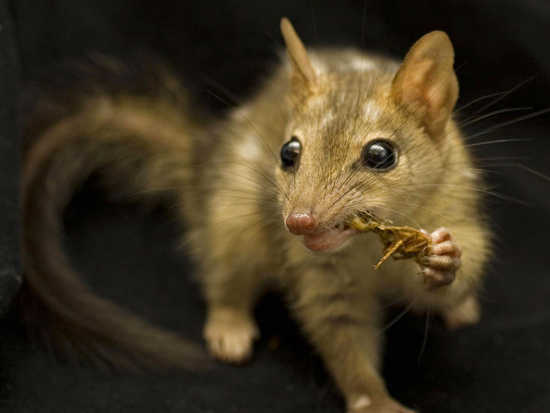博文
三维饮食调控与脂尾袋鼬体重和活动水平选择的后果
|||
三维饮食调控与脂尾袋鼬体重和活动水平选择的后果
Wilder, S. M., L. H. Yuan, C. Roumilhac, A. LeGal, D. Raubenheimer, S. J. Simpson and B. M. McAllan (2016). Three-dimensional diet regulation and the consequences of choice for weight and activity level of a marsupial carnivore. Journal Of Mammalogy 97(6): 1645-1651.
Many animals consume foods that vary in all 3 macronutrients: carbohydrates, lipid, and protein. Yet most studies of diet regulation only consider pairs of nutrients (protein and carbohydrate or protein and lipid). Diet regulation also extends beyond nutrient and energy intake to include sources of energy expenditure, such as changes in activity level. We used a right-angled mixture triangle design to quantify the 3-dimensional intake target of fat-tailed dunnarts, Sminthopsis crassicaudata, and to test the consequences of free choice for energy intake, weight gain, and activity level relative to a standard maintenance diet. Dunnarts consistently preferred a relatively high-lipid, low-protein, and low-carbohydrate diet in 3 separate feeding experiments. Dunnarts also consumed a higher total energy intake during choice relative to no-choice periods. However, the weight of dunnarts was not consistently higher at the end of choice relative to no-choice periods, which is likely because dunnarts increased their activity level during periods of choice and decreased their activity when on no-choice diets. This shows that increases in the intake of lipid, which is an important component in the diet of dunnarts, does not necessarily lead to increases in weight gain because these animals can adjust energy expenditure to balance their energy budget. These results have important implications for the design of diets for animals in captivity and demonstrate that consideration of both energy intake and expenditure are needed for a more comprehensive and integrative understanding of diet regulation by animals.
许多动物食用的食物都含有三种不同的常量营养素:碳水化合物、脂肪和蛋白质。然而,大多数关于饮食调节的研究只考虑成对的营养素(蛋白质和碳水化合物或蛋白质和脂肪)。饮食调节也不只是营养和能量摄入,还包括能量消耗来源,如活动水平的变化。我们使用直角混合三角形设计来量化脂尾袋鼬Sminthopsis crassicaudata的三维摄入量目标(就是三大营养素的摄入量),并测试自由选择能量摄入量、体重增加和活动水平相对于标准维持饮食的后果。在3个单独的喂养实验中,脂尾袋鼬一贯倾向于相对高脂、低蛋白质和低碳水化合物的饮食。与非选择期相比,脂尾袋鼬在选择期(有食物供选择)摄入的总能量也更高。然而,与非选择时期相比,在选择结束时,脂尾袋鼬的体重并不总是更高,这可能是因为脂尾袋鼬在选择时期增加了他们的活动水平,而在非选择饮食期间减少了他们的活动(多篇文章中对于体重没有增加,都认为是活动水平可能增加,但没有直接证据)。这表明,脂质是脂尾袋鼬饮食中的重要组成部分,脂质摄入量的增加并不一定会导致体重增加,因为这些动物可以调整能量消耗,以平衡其能量收支。这些结果对圈养动物的饲料设计具有重要的指导意义,表明需要同时考虑能量摄入和能量消耗,才能更深入全面地理解动物的饮食调控。

脂尾袋鼬
分布于澳大利亚和新几内亚。体长5~22公分(2~9寸),尾似帚,与身体等长。皮毛一般为纯灰色、浅黄色或褐色,少数种有斑点。形似鼠,但更像鼩鼱。多为夜行性,以昆虫和小型脊椎动物为食,把多馀的脂肪储存在尾部。(图片来源于网络)
https://m.sciencenet.cn/blog-3411995-1230277.html
上一篇:角类肥蛛的动态捕食和繁殖策略
下一篇:昆士兰食蛛结网恐蛛的猎物偏好(蜘蛛目:跳蛛科)
全部作者的其他最新博文
- • 实验2 体格检查
- • 实验1 牛乳掺伪的检验
- • 教学演练设计
- • [转载]怎样养成好习惯
- • 漏斗蛛
- • [转载]你知道你有5种不同的食欲吗?